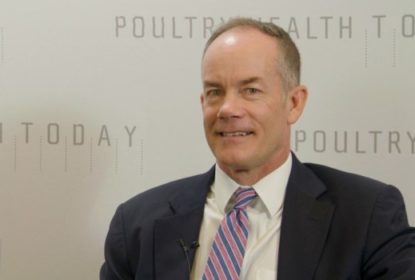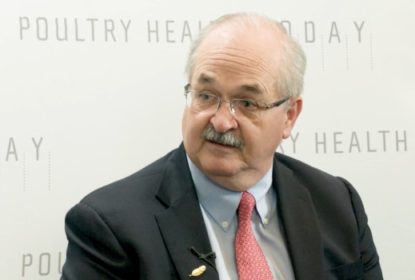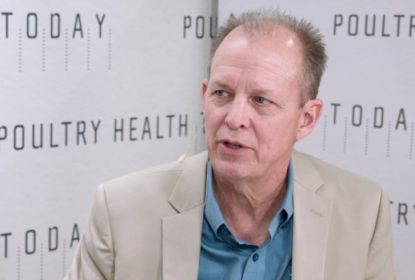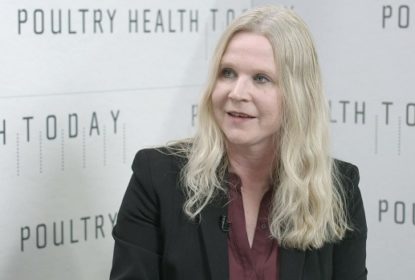Category Archive: Flock welfare, Global TOP NEWS, Infectious Diseases, Interviews, News, PHT GLOBAL, PHT US, Podcast, TOP NEWS, Videos

Flock welfare, Global TOP NEWS, Infectious Diseases, Interviews, News, PHT GLOBAL, PHT US, Podcast, TOP NEWS, Videos
... Back-to-basics for managing health of cage-free pullets
Dec 26, 2022Jennifer GrullonComments Off on Back-to-basics for managing health of cage-free pullets
Poultry producers with cage-free pullet systems should go back to the basics of bird management to keep their flocks healthy and productive.
Antibiotic-free, Biosecurity, Global TOP NEWS, Hatchery, Interviews, News, PHT GLOBAL, PHT US, Podcast, TOP NEWS, Videos
... Automation key to ensuring sanitation in ‘no antibiotics ever’ systems
Dec 25, 2022Jennifer GrullonComments Off on Automation key to ensuring sanitation in ‘no antibiotics ever’ systems
Labor shortages in hatcheries mean that to ensure appropriate levels of sanitation in “no antibiotics ever” production, wholesale automation is likely to be required.
Biosecurity, Flock welfare, Global TOP NEWS, Interviews, News, PHT GLOBAL, PHT US, Podcast, Research, TOP NEWS, Videos
... Circulation fans reduce severity of footpad dermatitis
Dec 22, 2022Jennifer GrullonComments Off on Circulation fans reduce severity of footpad dermatitis
Footpad dermatitis causes significant foot problems for broilers, which adversely affects bird welfare and the market for broiler paws, according to research from the University of Maryland.... Distinctive condition affects layers as well as turkeys, broilers
Dec 15, 2022Jennifer GrullonComments Off on Distinctive condition affects layers as well as turkeys, broilers
A disease commonly seen in turkey and broiler flocks can also affect layers, meaning that producers should look out for its distinctive signs.... Bugs should be a key focus of biosecurity in controlling turkey disease
Dec 15, 2022Jennifer GrullonComments Off on Bugs should be a key focus of biosecurity in controlling turkey disease
Producers should play close attention to insect control in their poultry houses to avoid cases of turkey coronavirus enteritis (TCE).... How effective IBV surveillance can prevent ‘overvaccination’
Dec 15, 2022Jennifer GrullonComments Off on How effective IBV surveillance can prevent ‘overvaccination’
Consistent surveillance and analysis of infectious bronchitis virus (IBV) at poultry production facilities can guard against “overvaccination” — where too much vaccine virus in the environment...... Shedding light on LED lamps and dimmers: They’re not all a match
Dec 15, 2022Jennifer GrullonComments Off on Shedding light on LED lamps and dimmers: They’re not all a match
Getting the correct lighting is important in poultry houses to help maximize the birds’ genetic potential; however, too often there’s a disconnect between the LED lamps and the dimmers in...... Agreed indicators should help drive poultry-industry welfare
Dec 13, 2022Jennifer GrullonComments Off on Agreed indicators should help drive poultry-industry welfare
Using key welfare indicators (KWIs) can help fill a communication gap around welfare progress in the US poultry industry.... Farm mortality issues highlight importance of checking water supply
Dec 07, 2022Jennifer GrullonComments Off on Farm mortality issues highlight importance of checking water supply
Producers need to be alert to the dangers of drinking-water toxicity issues, according to a senior industry veterinarian.... Coccidiosis: An old problem with some new challenges
Dec 01, 2022Jennifer GrullonComments Off on Coccidiosis: An old problem with some new challenges
Coccidiosis in broiler houses remains a nagging challenge. While clinical manifestations are rare, it’s the subclinical condition that impacts the flock through poor feed efficiency and reduced...
Flock welfare, Global TOP NEWS, Interviews, News, PHT GLOBAL, PHT US, Podcast, Research, TOP NEWS, Videos
... Environmental enrichments increased broiler activity in study
Nov 25, 2022Jennifer GrullonComments Off on Environmental enrichments increased broiler activity in study
Environmental enrichments in broiler houses may improve bird welfare by increasing natural behaviors, according to a University of Maryland study.
Biosecurity, Food Safety, Global TOPICS, Interviews, News, PHT GLOBAL, PHT US, Podcast, TOPICS, Videos
... Don’t overlook feed biosecurity in efforts to manage Salmonella
Nov 02, 2022Jennifer GrullonComments Off on Don’t overlook feed biosecurity in efforts to manage Salmonella
Biosecurity in feed mills and on-farm feed storage should not be overlooked when it comes to managing the risk of Salmonella in poultry flocks, according to a turkey-health expert.
Flock welfare, Global TOP NEWS, Hatchery, Interviews, News, PHT GLOBAL, PHT US, Podcast, Research, TOP NEWS, Videos
... Study: Day length during brooding did not impact broiler performance
Oct 20, 2022Jennifer GrullonComments Off on Study: Day length during brooding did not impact broiler performance
Extended day length during the brooding period is thought to benefit broilers’ long-term performance and well-being. However, a University of Georgia study has re-evaluated that idea.
Antibiotic-free, Flock welfare, Food Safety, Global TOP NEWS, Interviews, News, PHT GLOBAL, PHT US, Podcast, TOP NEWS, Videos
... Live-vaccine program a ‘must have’ to deal with cage-free E. coli challenge
Oct 10, 2022Jennifer GrullonComments Off on Live-vaccine program a ‘must have’ to deal with cage-free E. coli challenge
A higher risk of bacterial challenges in cage-free egg production means a live-vaccination program against Escherichia coli is a “must-have minimum” for flocks reared in alternative systems.... Managing layer health challenges as cage-free demand increases
Oct 07, 2022Jennifer GrullonComments Off on Managing layer health challenges as cage-free demand increases
In a special video from Poultry Health Today, experts from across the industry discuss the challenges facing producers who make the change from conventional systems to cage-free.... Breed may impact broiler response to Salmonella infection
Oct 06, 2022Jennifer GrullonComments Off on Breed may impact broiler response to Salmonella infection
Research at the University of Arkansas suggests broiler breed could affect birds’ immune response to Salmonella exposure, according to Shawna Weimer, PhD, director of the Center for Food Animal...... COVID pandemic had some positive effects on poultry health and welfare
Sep 29, 2022Jennifer GrullonComments Off on COVID pandemic had some positive effects on poultry health and welfare
Management techniques adopted to cope with COVID-19 production challenges led to improvements in bird health and welfare for many poultry producers.
Flock welfare, Food Safety, Global TOP NEWS, Interviews, News, PHT GLOBAL, PHT US, Podcast, Research, TOP NEWS, Videos
... Salmonella serotypes are changing — monitor which ones are in your flock
Sep 28, 2022Jennifer GrullonComments Off on Salmonella serotypes are changing — monitor which ones are in your flock
It’s imperative for poultry producers and companies to know what strains of Salmonella may be circulating in their flocks, said Chuck Hofacre, president of the Southern Poultry Research Group in...
Flock welfare, Global TOP NEWS, Hatchery, Interviews, News, PHT GLOBAL, PHT US, Podcast, TOP NEWS, Videos
... Recombinant vaccines for poultry: How to maximize results
Sep 22, 2022Jennifer GrullonComments Off on Recombinant vaccines for poultry: How to maximize results
Proper vaccine handling, dosage and administration are key to ensuring thorough and effective coverage. That statement is particularly true when talking about recombinant-vector vaccines.
Food Safety, Global TOP NEWS, Interviews, News, PHT GLOBAL, PHT US, Podcast, Research, TOP NEWS, Videos
... Study highlights risk of high Salmonella exposure, more persistent serotypes
Sep 10, 2022Jennifer GrullonComments Off on Study highlights risk of high Salmonella exposure, more persistent serotypes
Feed conversion takes a bigger hit in birds with higher Salmonella exposure, while Salmonella Reading outlasts other serotypes through the grow-out period, suggests new work from the University of...
Condemnations, Food Safety, Global TOP NEWS, Interviews, News, PHT GLOBAL, PHT US, Podcast, TOP NEWS, Videos
... USDA evaluating Salmonella-reduction steps along the poultry supply chain
Sep 08, 2022Jennifer GrullonComments Off on USDA evaluating Salmonella-reduction steps along the poultry supply chain
Almost 25% of US foodborne illnesses continue to be linked to poultry products. To get an accurate measure of product contamination, USDA is evaluating the poultry supply chain.... Genomic technology sheds light on Salmonella serotypes in breeder flocks
Aug 04, 2022Jennifer GrullonComments Off on Genomic technology sheds light on Salmonella serotypes in breeder flocks
A technology called CRISPR-SeroSeq, which amplifies a section of the Salmonella genome, is helping paint a clearer picture of the serotypes circulating in breeder flocks.
Flock welfare, Global TOPICS, Infectious Diseases, Interviews, News, PHT GLOBAL, PHT US, Podcast, Respiratory, TOPICS, Videos
... Why ‘vaccinated’ chickens still get infected with IBV — and what to do about it
Jul 26, 2022Jennifer GrullonComments Off on Why ‘vaccinated’ chickens still get infected with IBV — and what to do about it
While many vaccines and vaccination programs effectively protect against the highly contagious infectious bronchitis virus in poultry, outbreaks of the disease still occur in vaccinated flocks.
Flock welfare, Global TOPICS, Hatchery, Interviews, News, PHT GLOBAL, PHT US, Podcast, Research, Videos
... Light impacts behavior in cage-free aviaries
Jul 20, 2022Jennifer GrullonComments Off on Light impacts behavior in cage-free aviaries
Birds can move out of the reach of the workers’ hands in a multi-tier aviary system, so employees have to climb into the system to get to them. Researchers from Michigan State studied light...
Flock welfare, Global TOPICS, Infectious Diseases, Interviews, News, PHT GLOBAL, PHT US, Podcast, TOPICS, Videos
... Poultry industry can learn from COVID-19
Jun 09, 2022Jennifer GrullonComments Off on Poultry industry can learn from COVID-19
Biosecurity is not sufficient to control avian coronaviruses like infectious bronchitis in commercial poultry, no matter how good it is, said Mark Jackwood, PhD, a molecular virologist and professor...
Flock welfare, Food Safety, Global TOP NEWS, Interviews, News, PHT GLOBAL, PHT US, Podcast, Research, TOP NEWS, Videos
... ‘Competitive exclusion’ is potential benefit of live Salmonella vaccines in young birds
Jun 02, 2022Jennifer GrullonComments Off on ‘Competitive exclusion’ is potential benefit of live Salmonella vaccines in young birds
Live vaccines for Salmonella have been found to start offering protection within a few days of administration, acting “almost as a [form of] competitive exclusion,” said Chuck Hofacre, president...
Diagnostics, Flock welfare, Global TOPICS, Infectious Diseases, Interviews, News, PHT GLOBAL, PHT US, Podcast, Research, TOPICS, Videos
... Poor IBV vaccine performance in broiler study underlines need for surveillance
May 12, 2022Jennifer GrullonComments Off on Poor IBV vaccine performance in broiler study underlines need for surveillance
A whole-complex study of broiler breeders in Georgia found underwhelming infectious bronchitis vaccine performance – but with better surveillance and protocols, outcomes could be improved.... Turkey-farm study finds Salmonella Infantis prevalent
Apr 19, 2022Jennifer GrullonComments Off on Turkey-farm study finds Salmonella Infantis prevalent
Research studying Salmonella across one turkey producer’s farms found Salmonella Infantis to be by far the dominant serotype.
Biosecurity, Global TOP NEWS, Gut Health, Interviews, News, PHT GLOBAL, PHT US, Podcast, TOP NEWS, Videos
... Comparing necrotic enteritis litter models highlights performance impacts
Apr 06, 2022Jennifer GrullonComments Off on Comparing necrotic enteritis litter models highlights performance impacts
Reused litter from a previous NE challenge led to more severe subclinical performance impacts but fewer clinical signs of disease than in birds raised on fresh litter.... Conventional, recombinant MD vaccination protocols compared in long-lived birds
Mar 08, 2022Jennifer GrullonComments Off on Conventional, recombinant MD vaccination protocols compared in long-lived birds
TOOLBOX, Issue 34: An interview with Eduardo Muniz, DVM, Zoetis on research comparing conventional vaccine programs versus new protocols with vectored vaccines.... Sharing data can help manage layer-farm disease and increase production
Jan 04, 2022Jennifer GrullonComments Off on Sharing data can help manage layer-farm disease and increase production
Sharing and analyzing data at farm level and beyond can offer new insights that improve bird health and profitability on layer farms.
Diagnostics, Global TOP NEWS, Hatchery, Interviews, News, PHT GLOBAL, PHT US, Podcast, Respiratory, TOP NEWS, Videos
... Early infectious bronchitis virus infection causes more severe false layer syndrome
Dec 22, 2021Jennifer GrullonComments Off on Early infectious bronchitis virus infection causes more severe false layer syndrome
Exposure to IBV has been linked with cases of false-layer syndrome, where large cysts in the oviduct prevent birds from laying eggs.
Global TOP NEWS, Hatchery, Interviews, News, PHT GLOBAL, PHT US, Podcast, Respiratory, TOP NEWS, Videos
... Essential adjustments that improve IB vaccine efficacy in broilers
Dec 05, 2021Jennifer GrullonComments Off on Essential adjustments that improve IB vaccine efficacy in broilers
A few essential adjustments in the way infectious bronchitis vaccines are handled and administered at the hatchery can improve vaccine efficacy.... Ionophore status change would threaten bird health, sustainability, veterinarian warns
Dec 02, 2021Jennifer GrullonComments Off on Ionophore status change would threaten bird health, sustainability, veterinarian warns
There is no need to recategorize ionophores, used as feed additives against coccidiosis, as veterinary medicines, says UK poultry veterinarian Daniel Parker — and doing so could have severe...... Going with the flow: How to maximize the effectiveness of spray vaccination
Nov 10, 2021Jennifer GrullonComments Off on Going with the flow: How to maximize the effectiveness of spray vaccination
Attention to detail is vital when it comes to ensuring that spray vaccinations against respiratory diseases such as infectious bronchitis are as effective as they can possibly be, according to...... Measuring temperature of birds’ faces could help identify heat stress in flocks
Nov 08, 2021Jennifer GrullonComments Off on Measuring temperature of birds’ faces could help identify heat stress in flocks
Use of thermal imaging cameras to measure facial temperatures may offer a non-invasive option for assessing heat stress in commercial broilers, according to research from the University of Arkansas.... Shift to cage-free egg production prompts need to revise health and management plans
Oct 28, 2021Jennifer GrullonComments Off on Shift to cage-free egg production prompts need to revise health and management plans
Vaccinations and other preventative health measures are more critical than ever as the US egg industry shifts toward cage-free and no-antibiotics-ever production.
Biosecurity, Global TOP NEWS, Infectious Diseases, Interviews, News, PHT US, Podcast, TOP NEWS, Videos, Zoetis News Center
... Details matter when it comes to ILT vaccination success
Oct 06, 2021Jennifer GrullonComments Off on Details matter when it comes to ILT vaccination success
Attention to detail is key to successfully vaccinating broiler flocks against infectious laryngotracheitis (ILT), according to a poultry health expert.... Direct-fed microbials can impact Salmonella vaccine efficacy
Sep 22, 2021Jennifer GrullonComments Off on Direct-fed microbials can impact Salmonella vaccine efficacy
Some direct-fed microbial additives with live cultures have been found to impact the efficacy of modified-live vaccines.... Feed additive appears to benefit gut integrity in broilers with coccidiosis
Sep 16, 2021Jennifer GrullonComments Off on Feed additive appears to benefit gut integrity in broilers with coccidiosis
The feed additive sodium bisulfate administered to broilers during a coccidial challenge appeared to benefit gut integrity.... Hatchery tips for successful transition to NAE production
Sep 16, 2021Jennifer GrullonComments Off on Hatchery tips for successful transition to NAE production
Preventing birds from getting sick is perhaps the biggest challenge encountered when transitioning from conventional to “no antibiotics ever” (NAE) production.
Diagnostics, Global TOP NEWS, Interviews, News, PHT GLOBAL, PHT US, Podcast, Respiratory, TOP NEWS, Videos, Zoetis News Center
... Periodic IBV PCR testing is key to ensuring vaccination efficacy
Sep 09, 2021Jennifer GrullonComments Off on Periodic IBV PCR testing is key to ensuring vaccination efficacy
Complexes should regularly evaluate the infectious bronchitis viruses (IBV) prevalent on their farms to help determine which vaccines can provide the best protection possible.
Diagnostics, Global TOP NEWS, Infectious Diseases, Interviews, News, PHT GLOBAL, PHT US, Podcast, TOP NEWS, Videos
... Molecular test helps identify pathogenicity in new strains of infectious bursal disease virus
Sep 03, 2021Jennifer GrullonComments Off on Molecular test helps identify pathogenicity in new strains of infectious bursal disease virus
A genetic technique which could help improve predictions about the virulence of infectious bursal disease (IBDV) has identified pathogenicity in seven new strains of the virus which causes an...
Global TOP NEWS, Infectious Diseases, Interviews, News, PHT GLOBAL, PHT US, Respiratory, TOP NEWS, Videos
... Three keys to successful IBV control
Aug 09, 2021Jennifer GrullonComments Off on Three keys to successful IBV control
Highly contagious and constantly evolving, infectious bronchitis virus (IBV) is notoriously difficult to control.... Hatcheries in NAE production systems can’t cut corners on cleaning, husbandry
Aug 04, 2021Jennifer GrullonComments Off on Hatcheries in NAE production systems can’t cut corners on cleaning, husbandry
Hatcheries providing chicks for no antibiotics ever (NAE) production need to be meticulous with cleanliness and good husbandry practices in order for the program to succeed.
Global TOP NEWS, Infectious Diseases, Interviews, News, PHT GLOBAL, PHT US, Podcast, Respiratory, TOP NEWS, Videos
... Two years of IBV sampling underlines importance of surveillance work
Aug 03, 2021Jennifer GrullonComments Off on Two years of IBV sampling underlines importance of surveillance work
Large-scale collection of samples from producers across the southern US is helping shed new light on infectious bronchitis virus (IBV) in chicken flocks — including uncovering a new serotype of the...... Study: Larger particles in starter feed lead to better performance
Jul 08, 2021Jennifer GrullonComments Off on Study: Larger particles in starter feed lead to better performance
Starter feed of larger particles consumed by young chicks is associated with better performance during the lifetime of broiler birds, according to a study conducted at Mississippi State University.... Seasonal management in hatchery critical to improving chick viability
Jul 07, 2021Jennifer GrullonComments Off on Seasonal management in hatchery critical to improving chick viability
Optimizing hatchery conditions throughout the year is crucial to limiting chick mortality and maintaining long-term bird viability, according to a poultry health expert.
Antibiotic-free, Biosecurity, Food Safety, Global TOP NEWS, Interviews, News, PHT GLOBAL, PHT US, Podcast, Research, TOP NEWS, Videos
... Better management, biosecurity could mean lower Salmonella levels in NAE farms
Jul 03, 2021Jennifer GrullonComments Off on Better management, biosecurity could mean lower Salmonella levels in NAE farms
New research has suggested that Salmonella levels in no-antibiotics-ever (NAE) poultry systems could be lower than those on conventional broiler farms.
Biosecurity, Food Safety, Global TOP NEWS, Interviews, News, PHT GLOBAL, PHT US, Podcast, TOP NEWS, Videos
... Litter management can help control Salmonella Heidelberg
Jun 28, 2021Jennifer GrullonComments Off on Litter management can help control Salmonella Heidelberg
Ongoing studies to find ways of managing Salmonella Heidelberg loads in poultry litter have suggested that downtime is key to reducing the pathogen’s rates.
Food Safety, Global TOP NEWS, Gut Health, Interviews, News, PHT GLOBAL, PHT US, Podcast, Sustainability, TOP NEWS, Videos
... Right skills critical to managing increases in Salmonella, coccidiosis associated with cage-free egg production
Jun 23, 2021Jennifer GrullonComments Off on Right skills critical to managing increases in Salmonella, coccidiosis associated with cage-free egg production
Producers making the switch to cage-free egg production need to ensure they are properly prepared for managing potential increases in Salmonella and other health challenges.
Diagnostics, Global TOP NEWS, Infectious Diseases, Interviews, News, PHT GLOBAL, PHT US, TOP NEWS, Videos
... Diagnostics key to effective mycoplasma control
Jun 20, 2021Jennifer GrullonComments Off on Diagnostics key to effective mycoplasma control
Avian mycoplasmosis is a problem for poultry producers worldwide, but according to an expert, there’s no “one-size-fits-all” approach to managing it.... Control key to protecting flocks from more virulent, resistant E. coli
Jun 03, 2021Jennifer GrullonComments Off on Control key to protecting flocks from more virulent, resistant E. coli
Research shows many strains of E. coli are capable of causing disease directly. And with antibiotic resistance on the rise, control and prevention are essential.... Tackling stress key to protecting birds from coryza resurgence, says expert
Jun 02, 2021Jennifer GrullonComments Off on Tackling stress key to protecting birds from coryza resurgence, says expert
Limiting stress in broiler flocks is key to preventing birds from succumbing to an infectious respiratory disease which is showing a resurgence in some areas of the US, according to a poultry expert.... Good management and biosecurity vital to overcoming disease challenges in NAE systems
Jun 02, 2021Jennifer GrullonComments Off on Good management and biosecurity vital to overcoming disease challenges in NAE systems
Getting back to basics with bird and house management is key to overcoming coccidiosis and other health issues affecting producers using NAE systems.
Biosecurity, Diagnostics, Food Safety, Global TOP NEWS, Interviews, News, PHT GLOBAL, PHT US, Podcast, TOP NEWS, Videos
... Utilizing on-farm testing key to helping processors understand S. Infantis loads
May 25, 2021Jennifer GrullonComments Off on Utilizing on-farm testing key to helping processors understand S. Infantis loads
Using a range of testing methods for Salmonella Infantis can help broiler companies build a better picture of how effective interventions against the pathogen are performing.... E. coli vaccination in broilers: Is it worth the cost?
May 15, 2021Jennifer GrullonComments Off on E. coli vaccination in broilers: Is it worth the cost?
According to recent studies, E. coli vaccination may actually help broiler producers boost their bottom lines.
Global TOP NEWS, Infectious Diseases, Interviews, News, PHT GLOBAL, PHT US, Podcast, Research, TOP NEWS, Videos
... False layer syndrome linked to early infectious bronchitis exposure
May 14, 2021Jennifer GrullonComments Off on False layer syndrome linked to early infectious bronchitis exposure
Research is increasingly linking false layer syndrome to early exposure to infectious bronchitis virus. The condition prevents laying hens from producing eggs, but birds display few outward signs of...... Cross-protection vaccine protocols key to limiting DMV/1639 spread in US flocks
May 04, 2021Jennifer GrullonComments Off on Cross-protection vaccine protocols key to limiting DMV/1639 spread in US flocks
Combining serotype vaccines might be a popular approach to protecting flocks against evolving strains of infectious bronchitis virus, such as DMV/1639, but not all combinations work equally well.... Testing mixed control approaches important in controlling Salmonella in broilers
Apr 26, 2021Jennifer GrullonComments Off on Testing mixed control approaches important in controlling Salmonella in broilers
Commercial broiler farms often employ a multi-faceted approach in tackling Salmonella, but testing different combinations of control options together on a small scale before they are rolled out...... Good gut health starts before hatch, expert says
Mar 12, 2021Jennifer GrullonComments Off on Good gut health starts before hatch, expert says
To establish good gut health, measures to promote a healthy microbiome can’t begin soon enough, an expert reports.... Histopathology helping poultry plants use science to defend carcasses, minimize condemnations
Feb 24, 2021Jennifer GrullonComments Off on Histopathology helping poultry plants use science to defend carcasses, minimize condemnations
Veterinarians specializing in diagnosing disease in animal tissue are spending more time in processing plants helping minimize costly carcass condemnations while maintaining high food quality...... Serotype, presentation of IBH differ in large and small birds
Dec 18, 2020Jennifer GrullonComments Off on Serotype, presentation of IBH differ in large and small birds
More than one serotype has been the cause of inclusion body hepatitis (IBH) in broilers, which has presented differently in large- and small-bird complexes.... Coccidiosis in conventional flocks presenting a significant challenge
Dec 07, 2020Jennifer GrullonComments Off on Coccidiosis in conventional flocks presenting a significant challenge
A shift in microbiology could be responsible for a surge in coccidiosis problems being seen in conventional US broiler and pullets flocks, according to Pilgrim's DVM Suzanne Dougherty.
Flock welfare, Global TOP NEWS, Infectious Diseases, Interviews, News, PHT GLOBAL, PHT US, Podcast, Research, TOP NEWS, Videos
... Consider predominance of AL-2 variants when planning IBDV vaccination program
Nov 09, 2020Jennifer GrullonComments Off on Consider predominance of AL-2 variants when planning IBDV vaccination program
The AL-2 family of variants is the predominant strain of infectious bursal disease virus (IBDV) circulating among US broiler flocks, according to a recent survey.
Antibiotic-free, Global TOP NEWS, Gut Health, Interviews, News, PHT GLOBAL, PHT US, Podcast, Research, TOP NEWS, Videos
... Glutamine supplement shows promise in reducing necrotic enteritis
Oct 26, 2020Jennifer GrullonComments Off on Glutamine supplement shows promise in reducing necrotic enteritis
Supplementing poultry diets with glutamine could help reduce the severity of necrotic enteritis (NE), according to researchers.... Researchers decode clues to Salmonella Infantis control
Oct 05, 2020Jennifer GrullonComments Off on Researchers decode clues to Salmonella Infantis control
New research from Austria provides key regional insights into Salmonella Infantis, a foodborne pathogen that is closely linked with broiler farms and often resistant to antibiotics.... Treatment blend offers ‘exciting potential’ for Campylobacter control at processing
Sep 03, 2020Jennifer GrullonComments Off on Treatment blend offers ‘exciting potential’ for Campylobacter control at processing
Blending two commonly used antibacterial treatments could help processing facilities take better control of Campylobacter and reduce the risk of food-borne illnesses, according to scientists.... Veterinarian: Rethink layer health programs with move to cage-free
Sep 02, 2020Jennifer GrullonComments Off on Veterinarian: Rethink layer health programs with move to cage-free
The poultry industry’s gradual switch to cage-free egg production has underscored the need to rethink disease-control programs.... Managing the health challenges of moving to free-range egg production
Aug 31, 2020Jennifer GrullonComments Off on Managing the health challenges of moving to free-range egg production
Free-range egg production will bring major challenges to the way birds are produced, but it will also mean big shifts in the ways bird health and welfare need to be managed.... Training and management critical for cage-free egg production
Aug 27, 2020Jennifer GrullonComments Off on Training and management critical for cage-free egg production
Training chicks and pullets so they are prepared for life in cage-free egg systems is critical to ensuring they meet their full productive potential.
Antibiotic-free, Global TOP NEWS, Hatchery, Interviews, News, PHT GLOBAL, PHT US, Podcast, TOP NEWS, Videos
... Chick quality vital to no-antibiotics-ever success, consultant says
Aug 20, 2020Jennifer GrullonComments Off on Chick quality vital to no-antibiotics-ever success, consultant says
Focusing on chick quality from the moment eggs enter the incubator is critical to ensuring birds have the best chance of being healthy and productive in no-antibiotics-ever (NAE) systems.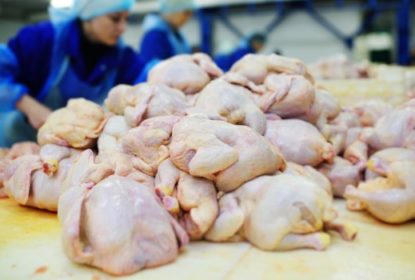
Condemnations, Food Safety, Global TOPICS, Interviews, News, PHT GLOBAL, PHT US, Podcast, TOPICS, Videos
... New avian leukosis rule expected to reduce waste, improve efficiency for processing plants and FSIS
Aug 13, 2020Jennifer GrullonComments Off on New avian leukosis rule expected to reduce waste, improve efficiency for processing plants and FSIS
Acceptance of a petition designating avian leukosis lesions on poultry carcasses as a trimmable condition is expected to reduce waste and improve efficiency at processing plants while allowing meat...
Flock welfare, Global TOPICS, Infectious Diseases, Interviews, News, PHT GLOBAL, PHT US, Podcast, TOPICS, Videos
... ND is stable in US but poultry industry should be on lookout for evolving strains
Jul 13, 2020Jennifer GrullonComments Off on ND is stable in US but poultry industry should be on lookout for evolving strains
Newcastle disease throughout most of the US remains stable, but the industry needs to be on guard for changes in the virus that may require adaption of ND vaccines.... Surveillance of circulating IBV types essential for disease control
Jul 06, 2020Jennifer GrullonComments Off on Surveillance of circulating IBV types essential for disease control
Surveillance aimed at pinpointing the type of infectious bronchitis virus that’s circulating in poultry flocks is essential to control of the disease.... USDA urged to give producers time to trial Campylobacter and Salmonella interventions
Jun 28, 2020Jennifer GrullonComments Off on USDA urged to give producers time to trial Campylobacter and Salmonella interventions
Greater flexibility is needed in official Salmonella and Campylobacter testing regimes in order to support poultry producers and processors who are trialing new interventions to tackle both... Study: Live S. Typhimurium vaccine reduces S. Infantis colonization
Jun 10, 2020Jennifer GrullonComments Off on Study: Live S. Typhimurium vaccine reduces S. Infantis colonization
Investing in vaccination programs to develop cross-protection against some of the most common strains of Salmonella could help limit the number of foodborne outbreaks of the pathogen.... Mountaire Farms is first company to carry the One Health Certified label
Jun 04, 2020Jennifer GrullonComments Off on Mountaire Farms is first company to carry the One Health Certified label
Mountaire Farms is the first animal protein company to carry the One Health Certified label, demonstrating its commitment to animal production standards established by the program.... Foster Farms: Community approach key to managing coryza spread in poultry
Apr 09, 2020Jennifer GrullonComments Off on Foster Farms: Community approach key to managing coryza spread in poultry
Tackling endemic poultry diseases as a community rather than as individual producers can play an important role in controlling and limiting their spread.... Good flock management key to managing Mycoplasma synoviae resurgence
Apr 02, 2020Jennifer GrullonComments Off on Good flock management key to managing Mycoplasma synoviae resurgence
Broiler producers need to take a fresh look at housing conditions and bird management to help counter the resurgence of Mycoplasma synoviae linked to an increase in raised without antibiotics (RWA)...... Measuring effectiveness of on-farm interventions key to Salmonella control
Mar 30, 2020Jennifer GrullonComments Off on Measuring effectiveness of on-farm interventions key to Salmonella control
Understanding the impact specific on-farm interventions can have on Salmonella is critical to helping the US poultry industry meet government standards around the disease, according to a leading...... Prestage Farms veterinarian: Processing chain communication critical to identify health issues early, reduce turkey condemnations
Mar 11, 2020Jennifer GrullonComments Off on Prestage Farms veterinarian: Processing chain communication critical to identify health issues early, reduce turkey condemnations
Developing good relationships across the processing chain can be critical in helping to identify and overcome issues on farm and in the processing plant.... Sanderson vet: Keeping up with variant reovirus strains remains challenging
Mar 06, 2020Jennifer GrullonComments Off on Sanderson vet: Keeping up with variant reovirus strains remains challenging
Poor uniformity, lameness and reduced water consumption are tip-offs that broilers may be infected with variant reovirus.... Swift communication key to limiting the risk of poultry disease outbreaks
Mar 05, 2020Jennifer GrullonComments Off on Swift communication key to limiting the risk of poultry disease outbreaks
Excellent systems of communication between farm staff and veterinarians are critical when it comes to managing disease outbreaks and reducing their potential spread.... Decisions, decisions: Which gut health strategies should be used when?
Feb 17, 2020Jennifer GrullonComments Off on Decisions, decisions: Which gut health strategies should be used when?
As the poultry industry moves to limit antibiotic use, alternative measures to support gut health are now common practice, but more guidance is needed with respect to which strategies to use under...... Hospitals offer inspiration for next-generation poultry biosecurity tools
Jan 03, 2020Jennifer GrullonComments Off on Hospitals offer inspiration for next-generation poultry biosecurity tools
Researchers in Canada are looking to human hospitals as inspiration for developing next-generation techniques to improve biosecurity on poultry farms.... ‘Causal’ pie chart can help manage necrotic enteritis
Dec 29, 2019Jennifer GrullonComments Off on ‘Causal’ pie chart can help manage necrotic enteritis
Use of a simple “causal” pie chart is proving to be a helpful tool for controlling necrotic enteritis (NE).... Managing anticoccidials: ‘It’s how you use them that’s important’
Dec 23, 2019Jennifer GrullonComments Off on Managing anticoccidials: ‘It’s how you use them that’s important’
Coccidiosis takes a toll of around $3 billion on global poultry production each year, making it one of the industry’s most economically significant diseases worldwide.... One Health Certified label seeks balanced approach to poultry production, marketing
Dec 23, 2019Jennifer GrullonComments Off on One Health Certified label seeks balanced approach to poultry production, marketing
A new label under development for meat and poultry products will represent production that seeks a balanced approach to poultry production and marketing.... E. coli vaccination yields bottom-line benefits on South African broiler farms
Dec 10, 2019Jennifer GrullonComments Off on E. coli vaccination yields bottom-line benefits on South African broiler farms
New research from South Africa shows that vaccinating broilers against Escherichia coli is good not just for birds, but also for bottom lines.... Industry needs more poultry scientists to tackle disease challenges
Dec 03, 2019Jennifer GrullonComments Off on Industry needs more poultry scientists to tackle disease challenges
More young people need to be encouraged to take up careers in poultry science if the sector is to properly tackle disease challenges which have plagued it for decades.... Salmonella’s sex life key to mitigating food safety risks
Nov 14, 2019Jennifer GrullonComments Off on Salmonella’s sex life key to mitigating food safety risks
Food safety challenges linked to Salmonella could be tackled more effectively by better understanding the sex life of bacteria, according to a leading US government veterinarian.
Global TOP NEWS, Infectious Diseases, Interviews, News, PHT GLOBAL, PHT US, Podcast, TOP NEWS, Videos
... Unusual presentation of bacterial septicemia in broilers tied to breeders
Oct 29, 2019Jennifer GrullonComments Off on Unusual presentation of bacterial septicemia in broilers tied to breeders
An unusual presentation of bacterial septicemia in broilers underscores the importance of obtaining a good history and input from bird caretakers, according to David French, DVM, a staff veterinarian...
Biosecurity, Food Safety, Global TOPICS, Interviews, News, PHT GLOBAL, PHT US, Podcast, TOPICS, Videos
... Perdue veterinarian seeks answers to inconsistent foodborne pathogen load
Oct 28, 2019Jennifer GrullonComments Off on Perdue veterinarian seeks answers to inconsistent foodborne pathogen load
Taking a closer look at why incidence of Salmonella and Campylobacter varied widely on farms in the same production system helped to demonstrate the importance of management and communication with...
Antibiotic-free, Flock welfare, Global TOPICS, Interviews, News, PHT GLOBAL, PHT US, Podcast, TOPICS, Videos
... Coccidiosis control: Keys to success with a bioshuttle program
Oct 20, 2019Jennifer GrullonComments Off on Coccidiosis control: Keys to success with a bioshuttle program
Resistance is unlikely to be a problem in coccidiosis bioshuttle programs, Greg Mathis, PhD, Southern Poultry Research, told Poultry Health Today.... Necrotic enteritis control requires multi-pronged approach in RWA systems
Oct 17, 2019Jennifer GrullonComments Off on Necrotic enteritis control requires multi-pronged approach in RWA systems
Feeding higher levels of copper and zinc in the diet, managing litter moisture and controlling coccidiosis are keys to stopping necrotic enteritis (NE) in poultry raised without antibiotics (RWA),...... Avian pathogenic E. coli: Difficult to prevent and control
Oct 10, 2019Jennifer GrullonComments Off on Avian pathogenic E. coli: Difficult to prevent and control
The bacterium E. coli has re-emerged in broiler operations, which seems to coincide with poultry companies’ switch to ‘no antibiotics ever’ (NAE) programs.
Diagnostics, Flock welfare, Global TOP NEWS, Infectious Diseases, Interviews, News, PHT GLOBAL, PHT US, Podcast, Respiratory, TOP NEWS, Videos
... Sentinel broilers, PCR testing help isolate, identify evolving IBV populations in Arkansas
Oct 07, 2019Jennifer GrullonComments Off on Sentinel broilers, PCR testing help isolate, identify evolving IBV populations in Arkansas
How do you look for new serotypes of a virus that might be circulating in an area? Sentinel birds are a good place to start, according to Abigail Reith, DVM, a technical services veterinarian for...... Reductions in medically important antimicrobials reflect industry stewardship
Oct 02, 2019Jennifer GrullonComments Off on Reductions in medically important antimicrobials reflect industry stewardship
Reductions in the use of medically important antimicrobials demonstrate the poultry industry’s commitment to stewardship of these valuable medications, Randall Singer, DVM, MPVM, PhD, told Poultry...
Antibiotic-free, Flock welfare, Global TOPICS, Interviews, News, PHT GLOBAL, PHT US, Podcast, Videos
... Helping contract growers’ transition to no-antibiotics-ever broiler production
Sep 29, 2019Jennifer GrullonComments Off on Helping contract growers’ transition to no-antibiotics-ever broiler production
Successful transition from conventional to no-antibiotics-ever (NAE) broiler production requires awareness of all the changes needed and lots of advance planning.
Flock welfare, Global TOPICS, Interviews, News, PHT GLOBAL, PHT US, Podcast, Sustainability, TOPICS, Videos
... Better air circulation, moderately lower humidity improve paw quality
Sep 23, 2019Jennifer GrullonComments Off on Better air circulation, moderately lower humidity improve paw quality
Increasing air circulation coupled with moderate reductions in humidity can dramatically improve paw quality, Michael Czarick and Connie Mou, University of Georgia, told Poultry Health Today.... US poultry industry shifting focus to Campylobacter, Salmonella Infantis
Sep 19, 2019Jennifer GrullonComments Off on US poultry industry shifting focus to Campylobacter, Salmonella Infantis
The US poultry industry needs to revisit Campylobacter-control strategies in preparation for new performance standards coming from USDA’s Food Safety and Inspection Service, Ashley Peterson,...... Sprinkler systems benefit animal welfare, reduce water use
Sep 12, 2019Jennifer GrullonComments Off on Sprinkler systems benefit animal welfare, reduce water use
Sprinkler systems used in conjunction with cool cells during hot summer weather can not only benefit animal welfare, they can dramatically reduce water use.... Wet bulb reservoirs can be source of bacterial contamination for hatching eggs
Sep 10, 2019Jennifer GrullonComments Off on Wet bulb reservoirs can be source of bacterial contamination for hatching eggs
Wet-bulb reservoirs in hatchery incubators should be included in the bacterial-monitoring program to ensure they aren’t the source of egg-shell contamination.... Vaccinated birds shown to have lower incidence of Salmonella at processing
Sep 04, 2019Jennifer GrullonComments Off on Vaccinated birds shown to have lower incidence of Salmonella at processing
Broilers vaccinated against Salmonella showed reduced levels of the pathogen at processing in a recent study, according to Charles Hofacre, PhD, president, Southern Poultry Research Group. Inc.... Coccidiosis vaccination impedes nutrient digestibility
Aug 30, 2019Jennifer GrullonComments Off on Coccidiosis vaccination impedes nutrient digestibility
Poultry veterinarians and production managers are all too familiar with coccidiosis and its impact on gut health, nutrient absorption, feed conversion and growth rate.... What makes a chick tick: Help non-farm audiences understand poultry’s needs
Aug 29, 2019Jennifer GrullonComments Off on What makes a chick tick: Help non-farm audiences understand poultry’s needs
Rather than adopt costly production practices that don’t necessarily benefit the health or welfare of poultry, veterinarians should work to educate non-farm audiences about a bird’s inherent...... Poultry litter management key to MS control
Aug 28, 2019Jennifer GrullonComments Off on Poultry litter management key to MS control
Litter topped the list of environmental factors most consistently positive for Mycoplasma synoviae (MS), Naola Ferguson, DVM, associate professor at the University of Georgia, told Poultry Health...... Preventive measures are only option for combatting key parasites in turkeys
Aug 19, 2019Jennifer GrullonComments Off on Preventive measures are only option for combatting key parasites in turkeys
Turkey producers will need to rely on preventive measures including biosecurity, good gut health and genetic selection to combat three key flagellated protozoan parasites that can affect their...... Zinc can help combat infectious bronchitis in poultry
Aug 14, 2019Jennifer GrullonComments Off on Zinc can help combat infectious bronchitis in poultry
Research on infectious bronchitis virus remains a top priority for the poultry industry. Not only is it widespread, but new serotypes also continue to emerge due to mutations and recombination events...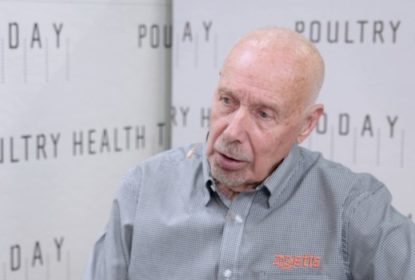
Antibiotic-free, Global TOP NEWS, Hatchery, Interviews, News, PHT GLOBAL, PHT US, Podcast, TOP NEWS, Videos
... Ensuring chick quality in NAE production
Jul 30, 2019Jennifer GrullonComments Off on Ensuring chick quality in NAE production
The increase in 7-day chick mortality that has come along with the elimination of antibiotics requires a focus on containing bacteria that start in the layer house.... Studies in chickens could lead to blackhead control in turkeys
Jul 26, 2019Jennifer GrullonComments Off on Studies in chickens could lead to blackhead control in turkeys
Broiler breeders are an ideal carrier for Histomonas — the cause of blackhead disease — but unlike turkeys that often die from the infection, broiler breeders survive.... Live-production management practices that help contain Salmonella
Jul 15, 2019Jennifer GrullonComments Off on Live-production management practices that help contain Salmonella
Avoidance of wet litter and well-timed feed withdrawal are two of several management steps that will help control the load of Salmonella going into the processing plant.... Focal duodenal necrosis in table-egg layers easily overlooked
Jul 15, 2019Jennifer GrullonComments Off on Focal duodenal necrosis in table-egg layers easily overlooked
Focal duodenal necrosis in table-egg layers can be an easily overlooked cause of drops in egg production and egg-case weight loss.... When vaccinating broilers against Salmonella may be worthwhile
Jul 09, 2019Jennifer GrullonComments Off on When vaccinating broilers against Salmonella may be worthwhile
Vaccinating broilers is a big investment and may not be needed on all farms, but it can be a worthwhile move if there are high loads of Salmonella coming into the processing plant.... Trial shows glutamine aids gut health in broilers raised without antibiotics
Jul 05, 2019Jennifer GrullonComments Off on Trial shows glutamine aids gut health in broilers raised without antibiotics
With the increase in no-antibiotic-ever production, glutamine may serve as a helpful nutrient asset, particularly when birds are under stress.... Pilgrim’s veterinarian shares experiences with NAE production
Jun 07, 2019Jennifer GrullonComments Off on Pilgrim’s veterinarian shares experiences with NAE production
Preparation, meticulous attention to sanitation and improved communication with hatchery staff and growers are critical for NAE production.... Four areas of hatchery management to help achieve better biosecurity
May 23, 2019Jennifer GrullonComments Off on Four areas of hatchery management to help achieve better biosecurity
Diligent attention to four areas of hatchery management — egg-pack quality, incubation, sanitation and in ovo vaccination — can go a long way.... Poultry producers facing higher hurdles with USDA food-safety standards
May 16, 2019Jennifer GrullonComments Off on Poultry producers facing higher hurdles with USDA food-safety standards
Poultry producers can expect to jump higher hurdles as USDA continues to raise the bar for food safety.... Moving up: Vaccinating broilers may help poultry companies improve Salmonella ratings
May 13, 2019Jennifer GrullonComments Off on Moving up: Vaccinating broilers may help poultry companies improve Salmonella ratings
Vaccinating broilers against Salmonella could be an effective live-side intervention for obtaining higher ratings in the Salmonella categorizations established by the USDA’s FSIS
Biosecurity, Global TOP NEWS, Infectious Diseases, Interviews, News, PHT GLOBAL, PHT US, Podcast, Respiratory, TOP NEWS, Videos
... Virulent ND in California sending wake-up call to US poultry industry
May 08, 2019Jennifer GrullonComments Off on Virulent ND in California sending wake-up call to US poultry industry
Outbreaks of virulent Newcastle disease (vND) that have spread from backyard to commercial flocks in California are providing a wake-up call to the entire US poultry industry.... Bioshuttle program helps control E. tenella outbreaks in pullets
May 02, 2019Jennifer GrullonComments Off on Bioshuttle program helps control E. tenella outbreaks in pullets
Administration of an in-feed anticoccidial after coccidiosis vaccination has helped alleviate outbreaks of Eimeria tenella in broiler breeder replacement stock.... Hatchery hygiene helps limit broiler E. coli mortality risk
Apr 24, 2019Jennifer GrullonComments Off on Hatchery hygiene helps limit broiler E. coli mortality risk
Disinfecting eggs and improving overall hygiene in the hatchery could dramatically reduce the risk of mortality linked to E. coli infections, scientists say.... Aggressive vaccination of broiler breeders needed to keep reovirus in check
Apr 18, 2019Jennifer GrullonComments Off on Aggressive vaccination of broiler breeders needed to keep reovirus in check
Aggressive vaccination of broiler breeders for reovirus using live and inactivated vaccines has been one of the most important steps the US poultry industry has taken to maintain good protection...... Life without antibiotics: Field lessons learned the hard way
Apr 15, 2019Jennifer GrullonComments Off on Life without antibiotics: Field lessons learned the hard way
Producers need to think long and hard before jumping into “no antibiotics ever” (NAE) poultry production.... Dirty chick boxes can be source of Salmonella at hatcheries
Apr 12, 2019Jennifer GrullonComments Off on Dirty chick boxes can be source of Salmonella at hatcheries
Dirty chick boxes at hatcheries can be a source of Salmonella, but the risk was still lower than expected in a study conducted at one US hatchery.
Diagnostics, Flock welfare, Global TOPICS, Interviews, News, PHT GLOBAL, PHT US, Podcast, Respiratory, TOPICS, Videos
... Genomic sequencing could aid ILT control efforts in poultry
Apr 09, 2019Jennifer GrullonComments Off on Genomic sequencing could aid ILT control efforts in poultry
Molecular virology is already leading to discoveries that will improve management of ILT, according to Stephen Spatz, PhD, molecular virologist with USDA’s Southeast Poultry Research Laboratory,...... Navigating the maze of alternative products for necrotic enteritis control
Apr 08, 2019Jennifer GrullonComments Off on Navigating the maze of alternative products for necrotic enteritis control
The effectiveness of antibiotic alternatives is going to vary among “no antibiotics ever” production systems, and it’s up to the producers to figure out which alternatives will work.
Flock welfare, Global TOPICS, Interviews, News, PHT GLOBAL, PHT US, Podcast, Sustainability, TOPICS, Videos
... Urban chicken movement requires legislators to learn chicken basics
Apr 04, 2019Jennifer GrullonComments Off on Urban chicken movement requires legislators to learn chicken basics
Legislators need to know some basics about raising chickens in response to an upsurge in the “urban chicken” trend, Nat Tablante, DVM, told Poultry Health Today.... Effective biosecurity requires addressing the culture of a company
Mar 29, 2019Jennifer GrullonComments Off on Effective biosecurity requires addressing the culture of a company
Effective biosecurity on poultry farms requires developing the kind of culture that motivates everyone in the company to adhere to the procedures that protect flocks from infectious disease.... Novel technologies needed to combat IB in chickens
Mar 27, 2019Jennifer GrullonComments Off on Novel technologies needed to combat IB in chickens
Despite decades of vaccination, the world poultry industry’s ongoing battle with infectious bronchitis (IB) continues to rage and points to the need for novel technologies to combat the disease.... Gizzard changes seen in NAE flocks but diagnosis is murky
Mar 21, 2019Jennifer GrullonComments Off on Gizzard changes seen in NAE flocks but diagnosis is murky
Raising broilers without antibiotics appears to be affecting the gizzard in ways that aren’t yet fully appreciated, and it’s not clear if the changes observed are true gizzard erosions, Jessica...... Biosecurity expert sees more room for improvement on poultry farms
Mar 19, 2019Jennifer GrullonComments Off on Biosecurity expert sees more room for improvement on poultry farms
Biosecurity on commercial poultry farms has come a long way but still has far to go, Joseph Giambrone, PhD, professor of poultry science, Auburn University, told Poultry Health Today.... Sanderson vet shares thoughts on managing elusive reovirus, other gut diseases
Mar 11, 2019Jennifer GrullonComments Off on Sanderson vet shares thoughts on managing elusive reovirus, other gut diseases
Autogenous vaccines used in a reovirus vaccination program need to be updated relatively often to keep up with changes in the pathogen
Global TOPICS, Infectious Diseases, Interviews, News, PHT GLOBAL, PHT US, Podcast, Respiratory, TOPICS, Videos
... Mycoplasma synoviae demanding more attention as poultry industry grasps its full impact
Feb 27, 2019Jennifer GrullonComments Off on Mycoplasma synoviae demanding more attention as poultry industry grasps its full impact
Emerging, variant strains of Mycoplasma synoviae are causing eggshell apex abnormalities as well as production drops in both layer and breeding flocks worldwide, Anneke Feberwee, DVM, PhD, from GD...... Lameness in poultry can start in the hatchery
Feb 27, 2019Jennifer GrullonComments Off on Lameness in poultry can start in the hatchery
Lameness in poultry is often associated with bird weight, bacterial infections or the condition of the litter, but it actually begins much earlier in the bird’s life — often in the hatchery.... Early exposure to Clostridium protects birds from necrotic enteritis
Feb 21, 2019Jennifer GrullonComments Off on Early exposure to Clostridium protects birds from necrotic enteritis
Early exposure to Clostridium perfringens in used litter may be a way to minimize the impact of necrotic enteritis (NE) in broilers, Steve Davis, DVM, told Poultry Health Today.... Necrotic enteritis control helps reduce Salmonella colonization
Feb 07, 2019Jennifer GrullonComments Off on Necrotic enteritis control helps reduce Salmonella colonization
Maintaining good intestinal health in broilers is essential for minimizing the presence of Salmonella in birds sent for processing, Manuel Da Costa, DVM, PhD, associate director for Outcomes Research...... New standards for foodborne pathogens expanding control programs to live production
Feb 06, 2019Jennifer GrullonComments Off on New standards for foodborne pathogens expanding control programs to live production
A rise in the prevalence of Salmonella on whole chicken carcasses since USDA changed the testing medium used could indicate the prevalence of the pathogen was previously underestimated.... Sanitation key to successful NAE production
Feb 04, 2019Jennifer GrullonComments Off on Sanitation key to successful NAE production
The key to successful “no antibiotics ever” (NAE) broiler production is cleanliness throughout every step of production, including a pristine hatchery.... Discrepancies emerge between animal welfare and consumer perceptions
Jan 30, 2019Jennifer GrullonComments Off on Discrepancies emerge between animal welfare and consumer perceptions
Poultry “raised without antibiotics” now account for more than 50% of the broilers in US production, but those reductions in antibiotics usage have consequences.... Vaccination of broilers ‘quick and easy’ way to get Salmonella under control
Jan 24, 2019Jennifer GrullonComments Off on Vaccination of broilers ‘quick and easy’ way to get Salmonella under control
Vaccination of broilers against Salmonella may be the best and most expedient option for producers struggling to meet USDA performance standards at the processing plant, said Chuck Hofacre, DVM, PhD,...... Refined carbs show promise as ‘sentinel’ for Salmonella control
Jan 23, 2019Jennifer GrullonComments Off on Refined carbs show promise as ‘sentinel’ for Salmonella control
Higher government standards for Salmonella control have put more pressure on poultry companies to reduce incidence on broiler farms and lower the pathogen load going into processing.... E. coli vaccination helps contain losses in broilers with IB infection
Jan 16, 2019Jennifer GrullonComments Off on E. coli vaccination helps contain losses in broilers with IB infection
Field experience with infectious bronchitis in broilers during a harsh winter demonstrated that vaccination for secondary Escherichia coli infection helped stem losses... Commercial poultry vets can help backyard growers, and themselves, by sharing tips on biosecurity
Jan 14, 2019Jennifer GrullonComments Off on Commercial poultry vets can help backyard growers, and themselves, by sharing tips on biosecurity
Improved communication between poultry company veterinarians and backyard chicken growers could help improve biosecurity and reduce disease spread for all flocks.
Antibiotic-free, Global TOP NEWS, Gut Health, Interviews, News, PHT GLOBAL, PHT US, Podcast, TOP NEWS, Videos
... Coccidiosis control, litter management key to NE prevention in broilers raised without antibiotics
Jan 10, 2019Jennifer GrullonComments Off on Coccidiosis control, litter management key to NE prevention in broilers raised without antibiotics
Good coccidiosis control and litter management are the two most important steps producers can take to prevent necrotic enteritis (NE) in flocks raised without antibiotics.... Heat-stress study shows need to increase ventilation with stocking density
Jan 09, 2019Jennifer GrullonComments Off on Heat-stress study shows need to increase ventilation with stocking density
As bird density increases, broiler producers need to be “more aggressive” with house ventilation to prevent heat stress in flocks, Brian Fairchild, PhD, professor, and Ming Lin Teo, graduate...... Chicks may hold clues to lameness in older birds
Jan 07, 2019Jennifer GrullonComments Off on Chicks may hold clues to lameness in older birds
Lameness in some poultry flocks has researchers searching for the cause, Suzanne Dougherty, DVM, a consulting poultry veterinarian based in Alabama, told Poultry Health Today.... It takes two: Coccidiosis vaccines effective against E. tenella after adequate cycling
Dec 26, 2018Jennifer GrullonComments Off on It takes two: Coccidiosis vaccines effective against E. tenella after adequate cycling
Coccidiosis vaccination was effective in broilers challenged with Eimeria tenella but only after vaccinal oocysts cycled twice, Laura Tensa, DVM, told Poultry Health Today.... Can water treatments help reduce Salmonella levels before processing?
Dec 06, 2018Jennifer GrullonComments Off on Can water treatments help reduce Salmonella levels before processing?
Feed withdrawal before moving broilers to the processing plant appears to increase their susceptibility to Salmonella, indicates research from the University of Georgia.... Is genetics the key for lasting IBV immunity?
Dec 03, 2018Jennifer GrullonComments Off on Is genetics the key for lasting IBV immunity?
Manipulating the immune response may be one way infectious bronchitis virus (IBV) is controlled in the future, predict researchers studying genetic lines of poultry.... IBV vaccination protects broilers despite ammonia exposure
Nov 19, 2018Jennifer GrullonComments Off on IBV vaccination protects broilers despite ammonia exposure
A recent study corroborates previous findings that broilers properly vaccinated for infectious bronchitis virus (IBV) are protected from IBV challenge despite exposure to moderate levels of ammonia.... Heat stress may impair immune system in broilers
Nov 08, 2018Jennifer GrullonComments Off on Heat stress may impair immune system in broilers
Heat stress in broilers induced lesions of lymphoid tissues, indicating immune system impairment, but it’s not yet known if heat stress affects the vulnerability or severity of coccidiosis.
Diagnostics, Global TOPICS, Interviews, News, PHT GLOBAL, PHT US, Podcast, Respiratory, TOPICS, Videos
... Consistency, follow-up key to controlling IBV
Nov 05, 2018Jennifer GrullonComments Off on Consistency, follow-up key to controlling IBV
Infectious bronchitis virus (IBV) is a “moving target” and trying to keep ahead of it requires consistency and follow-up, explained Sjaak de Wit, DVM, PhD, of GD Animal Health, the Netherlands.
Biosecurity, Global TOP NEWS, Infectious Diseases, Interviews, News, PHT GLOBAL, PHT US, Podcast, Respiratory, TOP NEWS, Videos
... Biosecurity, disinfection, downtime keys to better ILT control
Nov 01, 2018Jennifer GrullonComments Off on Biosecurity, disinfection, downtime keys to better ILT control
Strict biosecurity is the best defense against infectious laryngotracheitis (ILT) in broiler flocks, advises Maricarmen García, PhD, a professor at the University of Georgia.
Global TOP NEWS, Hatchery, Infectious Diseases, Interviews, News, PHT GLOBAL, PHT US, Podcast, TOP NEWS, Videos
... Halting in ovo vaccination not a good option for managing hatchery bacteria
Oct 22, 2018Jennifer GrullonComments Off on Halting in ovo vaccination not a good option for managing hatchery bacteria
Higher 7-day mortality from bacterial infections in the hatchery is no reason to stop in ovo vaccination for Marek’s and other diseases, according to a consulting poultry veterinarian.... Vaccination protects broilers from IBV despite exposure to moderate ammonia levels
Oct 21, 2018Jennifer GrullonComments Off on Vaccination protects broilers from IBV despite exposure to moderate ammonia levels
Properly vaccinated commercial broilers are protected from an infectious bronchitis virus (IBV) challenge despite exposure to moderate ammonia levels, according to a study that surprised researchers.... Uncertain supplies present challenges for rotation-minded producers
Oct 11, 2018Jennifer GrullonComments Off on Uncertain supplies present challenges for rotation-minded producers
Poultry producers know the importance of developing a long-term strategy for maintaining the efficacy of anticoccidials, but sometimes unexpected backorders of feed medications in high demand force...... Trace minerals, used litter, coccidiosis control key to managing enteritis in NAE flocks
Sep 06, 2018Jennifer GrullonComments Off on Trace minerals, used litter, coccidiosis control key to managing enteritis in NAE flocks
Starting broiler flocks on used litter, coupled with effective coccidiosis control and the use of trace minerals, can help minimize necrotic enteritis (NE) in broiler flocks raised without...... Marek’s and Salmonella: John Smith, DVM, offers insights on two new broiler-vaccination trends
Aug 23, 2018Jennifer GrullonComments Off on Marek’s and Salmonella: John Smith, DVM, offers insights on two new broiler-vaccination trends
John Smith, DVM, poultry veterinarian for Alectryon in Baldwin, Georgia, shared ideas with Poultry Health Today on two changes in broiler-vaccination strategies in the US poultry industry.... Coccidiosis control: New strategies for a new era
Aug 17, 2018Jennifer GrullonComments Off on Coccidiosis control: New strategies for a new era
Coccidiosis can be controlled in broilers without antibiotics as long as producers pay closer attention to hatchery coccidiosis vaccination procedures, brooding and stocking rates, Greg Mathis, PhD,...... Early identification needed to protect broilers from reovirus
Aug 16, 2018Jennifer GrullonComments Off on Early identification needed to protect broilers from reovirus
Reovirus is mutating every 2 to 3 years, which is making it difficult to protect broilers from the effects of the virus, Don Waldrip, DVM, technical service veterinarian for Zoetis, told Poultry...... Putting paper under chick’s drinkers: Is it really helpful?
Aug 08, 2018Jennifer GrullonComments Off on Putting paper under chick’s drinkers: Is it really helpful?
Placing paper under water lines increases water consumption by baby chicks, but only for the first 3 or 4 hours after house placement, research indicates.... Research focusing on new controls for coccidiosis, relationship with Salmonella
Aug 02, 2018Jennifer GrullonComments Off on Research focusing on new controls for coccidiosis, relationship with Salmonella
Alternative products for coccidiosis control remain the focus of research, but so far, the results are inconsistent, Sam Hendrix, DVM, veterinarian and researcher at Colorado Quality Research, told...... Let there be light: Early exposure to UV aids broiler behavior, performance
Jul 27, 2018Jennifer GrullonComments Off on Let there be light: Early exposure to UV aids broiler behavior, performance
Adding windows to poultry houses is an inexpensive way to improve the environment for broilers and possibly improve productivity, according to Rachel Lynn Dennis, PhD, assistant professor at the...... Footpad dermatitis a greater concern in chickens grown to older ages
Jul 26, 2018Jennifer GrullonComments Off on Footpad dermatitis a greater concern in chickens grown to older ages
Footpad dermatitis is more likely to be a problem among broilers grown to an older age, but it can be remedied if producers intervene in time, Tom Tabler, PhD, professor with Mississippi State...... Vaccination followed with feed medication gives pullets added protection against coccidiosis
Jul 02, 2018Jennifer GrullonComments Off on Vaccination followed with feed medication gives pullets added protection against coccidiosis
Inadequate coccidiosis protection in pullets can lead to health issues ranging from uneven weight gain to mortality.
Global TOP NEWS, Infectious Diseases, Interviews, PHT GLOBAL, PHT US, Podcast, Respiratory, TOP NEWS, Videos
... Is MS the next ‘big, bad Mycoplasma’ for US poultry?
Jun 20, 2018Jennifer GrullonComments Off on Is MS the next ‘big, bad Mycoplasma’ for US poultry?
The US poultry industry is reporting more problems with virulent Mycoplasma synoviae according to Naola Ferguson, DVM... Team effort by human, animal sectors needed to ensure responsible antibiotic use worldwide
Jun 14, 2018Jennifer GrullonComments Off on Team effort by human, animal sectors needed to ensure responsible antibiotic use worldwide
While the poultry and livestock sectors have drawn the ire of consumer and medical groups for the growth of antimicrobial resistance, it is wrong to “partition blame,” Randy Singer, DVM, PhD,...... Vaccinating broilers against Salmonella can help reduce pathogen’s prevalence at processing
May 24, 2018Jennifer GrullonComments Off on Vaccinating broilers against Salmonella can help reduce pathogen’s prevalence at processing
Vaccination of broilers against Salmonella can help poultry producers reduce the pathogen’s prevalence at processing and may also benefit bird performance, Kalen Cookson, DVM, director of clinical...... On-farm Salmonella control helps prevent processing plant contamination
May 11, 2018Jennifer GrullonComments Off on On-farm Salmonella control helps prevent processing plant contamination
Contaminated chicken feathers and feet may be the primary vectors for transmitting Salmonella from poultry houses to processing plants, according to Martha Pulido, DVM, PhD, Mississippi State...... ‘Turkeys are suffering’ without good control of coccidiosis
May 04, 2018Jennifer GrullonComments Off on ‘Turkeys are suffering’ without good control of coccidiosis
Turkeys are suffering from coccidiosis due to a lack of available medications, according to Greg Mathis, PhD, Southern Poultry Research, Athens, Georgia.... Industry trendwatcher offers insights on future of antibiotic-free poultry production
May 01, 2018Jennifer GrullonComments Off on Industry trendwatcher offers insights on future of antibiotic-free poultry production
Industry trendwatcher and analyst Greg Rennier, PhD, recently sat down with Poultry Health Today to share his thoughts on antibiotic-free production and where the poultry industry is heading in 2017...... Foregoing CAV breeder vaccination based on ELISA results can backfire
Apr 19, 2018Jennifer GrullonComments Off on Foregoing CAV breeder vaccination based on ELISA results can backfire
Not vaccinating broiler breeders for chicken anemia virus (CAV) because ELISA results show detectable antibodies could be asking for trouble, says Guillermo Zavala, DVM, PhD, Avian Health...... C. perfringens on broiler meat can survive processing, potentially sicken consumers
Apr 16, 2018Jennifer GrullonComments Off on C. perfringens on broiler meat can survive processing, potentially sicken consumers
Listen to or download the podcast Most broiler producers know the economic impact of necrotic enteritis caused by Clostridium perfringens, particularly in birds raised without antibiotics. Now...... Woody breast continues to baffle researchers
Apr 12, 2018Jennifer GrullonComments Off on Woody breast continues to baffle researchers
Woody breast is a relatively new disease that adversely affects meat quality during processing, but poultry scientists still don’t understand it’s underlying causes, said Luke Borst, DVM, PhD, a...... Biosecurity: ‘It doesn’t have to be boring’
Apr 10, 2018Jennifer GrullonComments Off on Biosecurity: ‘It doesn’t have to be boring’
Even though biosecurity is a critically important subject, many poultry producers tune it out — for the simple reason that it bores them, said Nathaniel Tablante, DVM, a professor and poultry...... Two symposia on poultry enteric disease set stage for 2018 AAAP Conference
Apr 05, 2018Jennifer GrullonComments Off on Two symposia on poultry enteric disease set stage for 2018 AAAP Conference
Two symposia focused on enteric disease in poultry will be held immediately prior to the 2018 American Association of Avian Pathologists (AAAP) annual conference set for this July in Denver.... Seven misconceptions about IBD in broilers
Mar 30, 2018Jennifer GrullonComments Off on Seven misconceptions about IBD in broilers
Kalen Cookson, DVM, is the director of clinical research, poultry, Zoetis. He explained the common misconceptions about infectious bursal disease (IBD) to Poultry Health Today.... How mutations, antigenic drift affect IBD management
Feb 19, 2018Jennifer GrullonComments Off on How mutations, antigenic drift affect IBD management
Farms affected by variant infectious bursal disease (IBD) viruses may find that currently available IBD vaccines aren’t always effective, said Daral Jackwood, PhD, professor in food animal research...... Why infectious bronchitis is so resilient — and what broiler companies can do about it
Feb 16, 2018Jennifer GrullonComments Off on Why infectious bronchitis is so resilient — and what broiler companies can do about it
Control of infectious bronchitis (IB) requires good biosecurity, good management and rigorous administration of a vaccine that matches the circulating virus as closely as possible, John Smith, DVM,...
Antibiotic-free, Interviews, ippe2016- Interviews with experts, PHT GLOBAL, PHT US, Sustainability, Videos
... Antibiotic-free poultry production: Is it sustainable on a large scale?
Feb 13, 2018Jennifer GrullonComments Off on Antibiotic-free poultry production: Is it sustainable on a large scale?
Phil Stayer, DVM, head veterinarian at Sanderson Farms, is worried about what he calls an "anti-technology movement" directed at the US poultry industry, particularly as it relates to veterinary care...... Clostridial dermatitis: Why is it so prevalent in turkeys?
Feb 09, 2018Jennifer GrullonComments Off on Clostridial dermatitis: Why is it so prevalent in turkeys?
Skin lesions in turkeys open the door to Clostridium infections and clostridial dermatitis, the most important disease in the turkey industry, according to a study by Kakambi Nagaraja, PhD,...... Get the most from your ELISA tests
Jul 15, 2014Jennifer GrullonComments Off on Get the most from your ELISA tests
Andrea Zedek, a veterinarian at Zoetis Inc., offers tips for ensuring accuracy when using ELISA tests to diagnose a poultry flock's health status.










































